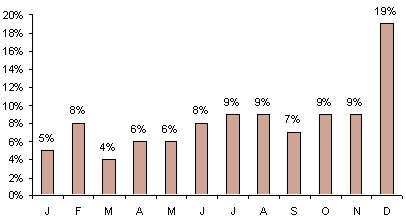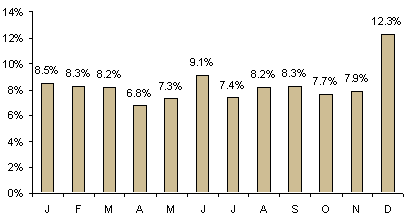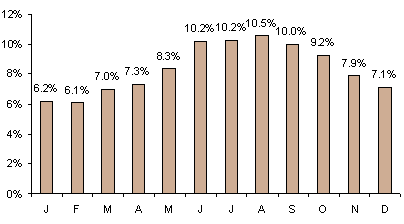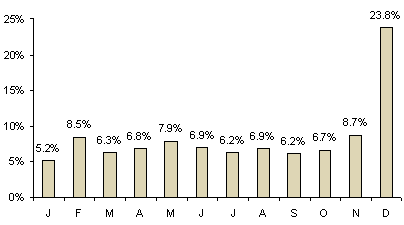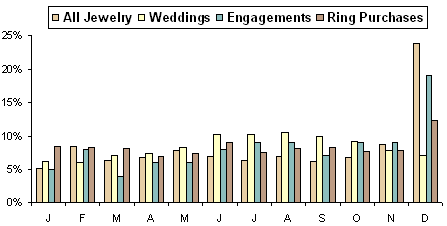IDEX Online Research: Bridal Jewelry Business High-Growth & Less Seasonal
April 19, 07
In addition, the bridal jewelry business is much less seasonal than other jewelry categories. While most jewelers generate more than one-third of their sales in the all-important holiday selling season of November and December, only about 20 percent of all engagement ring sales occur in November and December.
The following highlights are from IDEX Online Research Director Ken Gassman’s speech, Bridal Jewelry Demand: Set to Soar, at the American Gem Society’s Conclave in Denver, Colorado, in late April 2007.
Bridal Jewelry Demand: Growth to Accelerate
Bridal jewelry represents a dramatic opportunity for jewelers for the following reasons:
- Growth of bridal jewelry demand will be dramatic over the next decade
- The average ticket for bridal jewelry is almost ten times as large as the average ticket for a mass market specialty retailer
- The lifetime value of a young jewelry shopper can be enormous for specialty jewelers who are willing to work hard to keep that customer coming back into their store
- Today’s young consumers have disproportionally more money to spend on discretionary purchases than earlier generations
- Bridal jewelry is a much less seasonal business than other jewelry categories.
Based on the latest statistics from the U.S. National Center for Health Statistics, the typical first-time groom is 26.8 years old and the typical first-time bride is 25.1 years old. These averages are moving up at a rate of a couple of months per year. However, despite rhetoric that “brides and grooms are waiting much later to be married”, or “more couples are living together without the benefit of a legal union”, these trends not showing up in the statistics. In fact, the number of couples living together without the benefit of a legal union is trending down, based on new census data which measures such unions per thousand households.
The following graph illustrates the expected growth trends in the number of U.S. weddings, based on couples continuing to get married at around age 26 or 27.
| U.S.Weddings |
Bridal Jewelry Sales Much Less Seasonal
There are many old adages about brides, grooms, and weddings. One is that most weddings occur in June. Like most old adages, that simply isn’t true. The wedding business is a year-round business. As a result, the wedding jewelry business is a year-round business, too.
The following graph illustrates the seasonality of engagements in the U.S. market. As expected, a disproportionate number of engagements occur in December. This is likely a result of a large number of grooms proposing under the mistletoe or around the Christmas tree.
| Engagements - Seasonality Source: Fairchild |
When engagements occur, the groom usually gives the bride-to-be a diamond engagement ring. According to the Diamond Information Center (DIC), about 84 percent of all U.S. brides receive a diamond engagement ring. In 2006, the typical diamond engagement ring had an average ticket of $3,200, according to the DIC. That is almost ten-fold as large as the typical average ticket of $350 for a mass market specialty jeweler.
The following graph illustrates engagement ring sales in the U.S. market by month. The data is courtesy of National Jeweler.
| Buy Engagement Ring - Seasonality |
While the number of weddings tends to increase in the summer months, they occur all year long. As a result, jewelers can tap into a non-seasonal growing market for groom’s rings, attendants’ jewelry, and wedding gifts.
The graph below illustrates the seasonality of weddings by month in the U.S. market.
| Weddings - Seasonality |
In contrast to bridal jewelry, total jewelry sales are much more seasonal, as the graph below illustrates. Most U.S. jewelers generate one-third of their annual sales in the holiday selling period of November and December.
| Jewelry Sales Seasonality |
Putting It All Together
If we take the four graphs above illustrating seasonal trends in the jewelry business and put them on a single graph, it becomes very clear that bridal and wedding jewelry demand is much less seasonal than the total jewelry category.
| Seasonality Related to Wedding Jewelry |
Young Consumers Have Money to Spend
According to the latest information from the U.S. Department of Commerce Consumer Expenditure Survey (2004 Edition), the typical U.S. shopper age 25-34 has a “wealth factor” of about $150,000, including their annual income, their savings and investments, and the value of their home. That is disproportionately higher than at anytime in the past few decades. Thus, these young consumers have month to spend.
The table below summarizes the “wealth factor” for U.S. consumers by age group.
| Demographics by Age |
Not only are young consumers wealthier, but they are more willing to spend their wealth than many other consumer age segments.
As the graph below illustrates, spending on jewelry as a gift by young American consumers age 25-34 is the second highest of any age group. Obviously, much of this spending on jewelry as a gift is going toward bridal-related jewelry. In addition, couples are typically having their first child in this age range. Grandparents and friends tend to dote on first children, and expensive gifts are typically lavished on those first-born. Thus, the lifetime value to a jeweler of the young bride and groom can be enormous, if they are willing to make the effort to keep those customers.
| Gift Spending on Jewelry |

